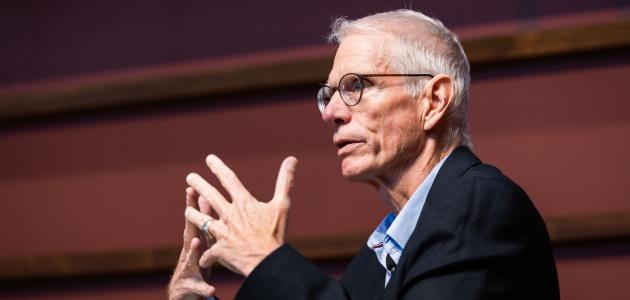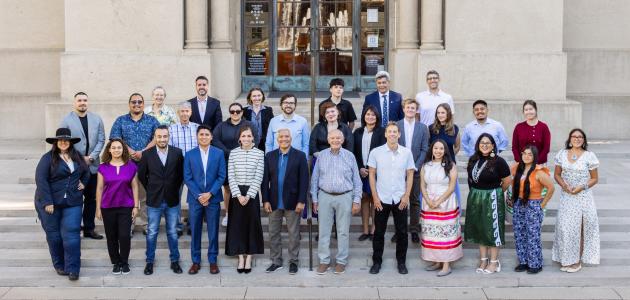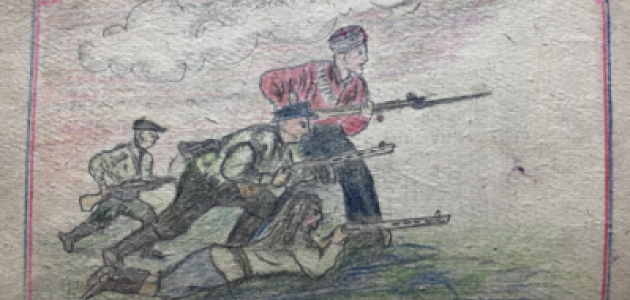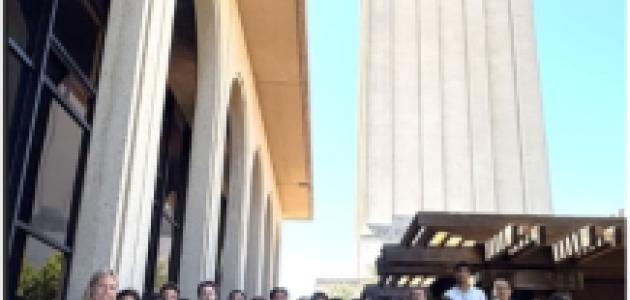STANFORD—George P. Shultz, Henry Kissinger, William Perry, Sam Nunn, and others called for a world free of nuclear weapons at a conference held at the Hoover Institution on October 24-25.
Their comments were made during a panel discussion following a dinner organized in conjunction with the institution’s “Reykjavik Revisited: Steps toward a World Free of Nuclear Weapons” conference.
George P. Shultz, former secretary of state and the Thomas W. and Susan B. Ford Distinguished Fellow at the Hoover Institution, hosted the panel discussion, asking each panelist to share his thoughts on nuclear weapons and nonproliferation.
Former secretary of state Henry Kissinger said he believes that nuclear nonproliferation is the most important issue facing the world today. Kissinger recalled that as security adviser he reviewed war plans, which included the use of nuclear weapons, and found that they would be difficult to recommend. “After a nuclear explosion of any magnitude, the world will never be the same again,” Kissinger said.
Sam Nunn, former chairman of the Senate Armed Services Committee and chief executive officer of the Nuclear Threat Initiative, said his views had evolved over the years. During the cold war he had always supported a strong defense effort, which he believes prevented an all-out war. “Now,” he said, “it’s necessary to take steps [to eliminate nuclear weapons] for a secure world. It’s going to take quite a while, but it’s time to get started.”
During his early government service, former secretary of defense and Hoover senior fellow William Perry said that he received a false alarm that 200 Soviet missiles were on their way to the United States. “At the time, it certainly impressed on me the danger of the way we were living in the cold war,” Perry said. Perry concluded that he no longer believes it is necessary to live with the fear of such a mistake.
Perry’s remarks led to a comment by Nunn on the need for the United States and Russia to to create a joint alert system and to work together to prevent catastrophic nuclear terrorist attacks, which he believes pose the greatest threat.
Sidney Drell, Hoover senior fellow and professor of theoretical physics (emeritus) at the Stanford Linear Accelerator Center, discussed steps toward eliminating nuclear weapons that were established at Hoover’s first Reykjavik conference in 2006. The steps were outlined in an op-ed written by Shultz, Perry, Kissinger, and Nunn titled “A World Free of Nuclear Weapons” (Wall Street Journal, January 4, 2007). Some of these steps, analyzed at this year’s conference, include changing the cold war posture of deployed nuclear weapons to increase warning time; reducing the size of nuclear forces in all states that possess them; initiating a bipartisan process within the Senate leading to ratification of the Comprehensive Nuclear Test Ban Treaty; and providing the highest possible standards of security for all stocks of weapons, weapons-usable plutonium, and highly enriched uranium throughout the world. Drell questioned the need for the current number of nuclear weapons that the U.S. and Russia have aimed at each other. He believes there are steps that can be taken to reduce those numbers.
The theme of former U.S. ambassador Max Kampelman’s remarks was the importance of moving from ought to is. He compared the goals of the Reykjavik II conference to those of the U. S. Constitution. Kampelman said that the principles of the Constitution may have seemed idealistic when they were introduced, but the founders had a vision that what ought to be would eventually become reality. Kampelman believes that pursuing zero tolerance of nuclear weapons is a goal the U.S. government should energetically pursue to prepare for the future. “What ought calls for is to get rid of nuclear weapons,” he declared.
California governor Arnold Schwarzenegger was forced to cancel his appearance at the dinner in order to supervise efforts to fight the devastating wildfires in Southern California. George Shultz read Schwarzenegger’s prepared speech, in which the governor recalled his childhood in Austria under the ever present threat of invasion by the USSR, potential conflict between the USSR and the United States, or a possible nuclear accident. Schwarzenegger pointed out that the nuclear threat has returned in the form of terrorists who, unlike Soviet Union leaders, would not hesitate to use such weapons. “Clearly, the attention focused on nuclear weapons should be as prominent as that of global climate change,” Schwarzenegger wrote.
In the course of his own remarks, George Shultz read a letter from Nancy Reagan, who expressed her gratitude for his efforts to rid the world of nuclear weapons. Mrs. Reagan wrote: “It was always Ronnie’s dream that the world would one day be free of nuclear arms. He felt that as long as such weapons were around, sooner or later they would be used. The result would be catastrophic.”
The purpose of the conference, sponsored by the Hoover Institution in collaboration with the Nuclear Threat Initiative, was to rekindle the vision of a world free of nuclear weapons discussed by President Ronald Reagan and General Secretary Mikhail Gorbachev during their 1986 summit in Reykjavik, Iceland. The conference focused on developing concrete steps toward realizing Reagan and Gorbachev’s vision. This is the second Hoover Institution conference on the topic; the first was held in October 2006 on the 20th anniversary of the Reagan-Gorbachev Reykjavik summit.
Click here for information about Implications of the Reykjavik Summit on Its Twentieth Anniversary: Conference Report, a book edited by Sidney Drell and George Shultz.












